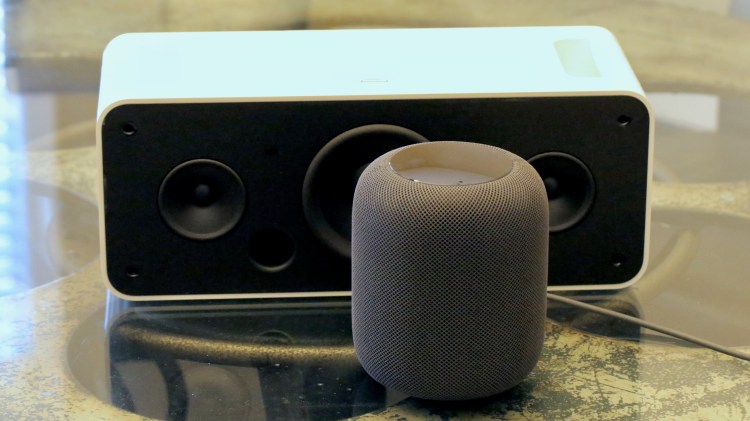Watch all the Transform 2020 sessions on-demand here.
Apple’s “smart speaker” HomePod was released last Friday, and if you’re considering buying one, you’ve probably already read our earlier coverage — and perhaps visited an Apple Store to hear one for yourself. Assuming you have the $349 to spend, my advice last week was to bring one home, audition it in your room of choice, and decide whether it fits into your life.
Today, you might be able to skip that visit, as this full review may answer your questions without a personal audition. In short, the HomePod is a somewhat different beast from Apple’s long-since-discontinued iPod Hi-Fi: It’s best understood as a small, bass-heavy speaker that will fit into your life if you enjoy using Apple’s digital assistant Siri. If you’re bothered by either a bassy audio skew or the thought of relying on Siri, skip HomePod and use your money toward a pair of excellent Sonos One speakers instead.
Basic pitch: A Wi-Fi smart speaker for any room
Looking past the HomePod’s tech specs page, the best way to understand Apple’s first smart speaker is as a place-it-anywhere performer of Apple Music — or any music you’ve stored with Apple’s iTunes Match service. Measuring just under 7″ tall and 6″ in diameter, it exists almost exclusively to stream audio, performing it in mono, not stereo.

June 5th: The AI Audit in NYC
Join us next week in NYC to engage with top executive leaders, delving into strategies for auditing AI models to ensure fairness, optimal performance, and ethical compliance across diverse organizations. Secure your attendance for this exclusive invite-only event.
If you’re expecting it to do anything else, you’ll probably be disappointed. HomePod has no charging dock, no audio-in port, and no way to receive music over Bluetooth. For now, it’s a completely closed system, and presently won’t stream directly from Spotify or other third-party apps. This may change over time, but for the time being, expect HomePod to be limited. Whether you’re cool with that or not will depend on what you expect from a “smart speaker.”
Pro: HomePod is easy to set up and fairly easy to use
I found setting up HomePod for the first time to be almost effortless. As there’s no remote control and no power button, the only thing to do is plug HomePod into the wall — it cannot run off of batteries. During the initial setup, HomePod’s Siri voice and your iOS device will work together, prompting you for permission to share Wi-Fi, iTunes, and iCloud settings, among other things.

You step through six or seven screens — depending on whether you need to go through Apple’s now ubiquitous Apple Music sales pitch — and then your iOS device’s screen will prompt you to try some basic Siri commands. That’s pretty much it: HomePod’s ready to use.
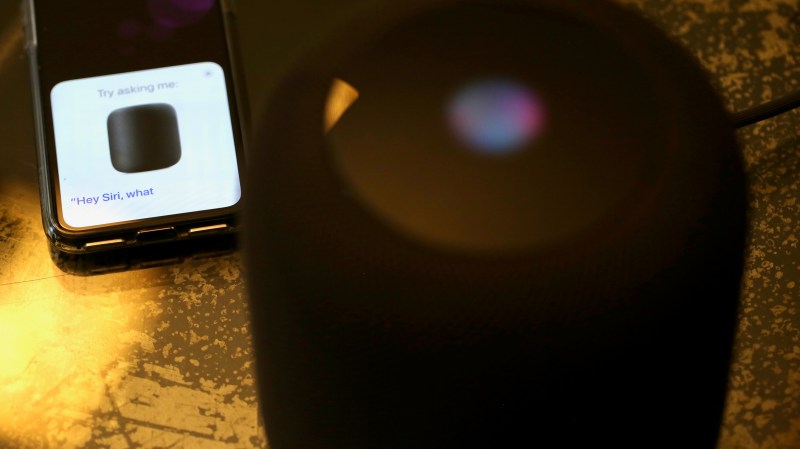
Whenever HomePod hears the phrase “Hey Siri,” a circle of lights will swirl on its top while it’s listening, processing your requests, and responding. If you have multiple Siri devices in the room, HomePod will be the device Siri responds from, pre-empting the others. I had only one issue with that: All of the devices that can hear you will be triggered, briefly interrupting whatever people are doing on their screens. Ideally, there would be a way to evoke Siri on HomePod with “Hey, HomePod” to avoid iOS device triggering.
Pro: It fits easily in any room
I tested HomePod all throughout a house, and it was easy to place anywhere: It fits effortlessly in bedrooms, a dining room, an office, a family room, and a living room. Because it’s so small and has a fairly long power cable, there was always an existing space where it could work, and I could always find a power outlet close enough to plug it in without stretching. Visually, the Space Gray version I selected blends in wherever it sits.
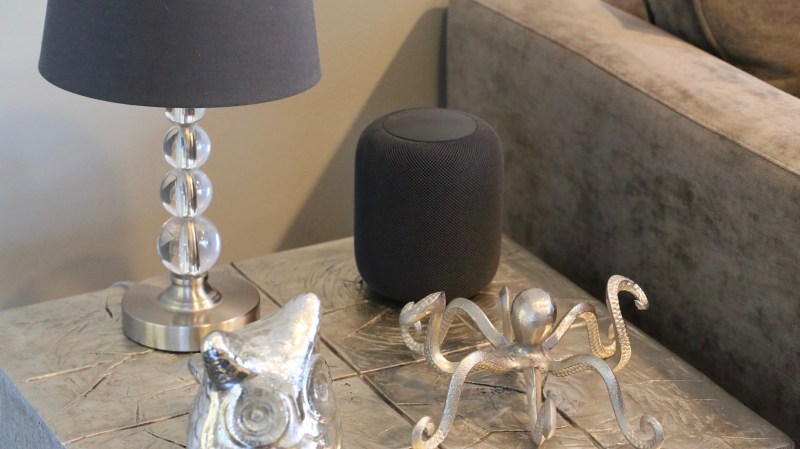
That said, I don’t love how HomePod looks, and everyone in my family similarly shrugged when asked for their opinions. Given Apple’s design philosophy, it should perhaps come as no surprise that the HomePod is a visually neutral object — less shiny and standout than the similarly shaped Mac Pro, thanks to its wraparound diamond mesh plastic and fabric grille. But unlike an iPhone X, it doesn’t have any conspicuous premium touches. Upon first inspection, my older daughter asked me why Apple keeps making products that look like little trash cans, and I didn’t have an answer for her.
The top is glossy plastic, the bottom matte rubber, touches that make sense to give it flash and practicality, respectively. If you never touch it, controlling it solely through speech, the top will only show dust rather than fingerprint smudges. But within hours of starting to use the HomePod, we found that three distinct fingerprint areas formed on the top, indicating where the volume up, volume down, and Siri/track control areas appear when illuminated. We also found that we were using the on-device track controls a lot more than we’d wanted, because it was a pain to wait for Siri to skip multiple tracks. (* Reader Pulin K. helpfully notes that there’s a buried way to use the iOS Music app to take control over playback.)
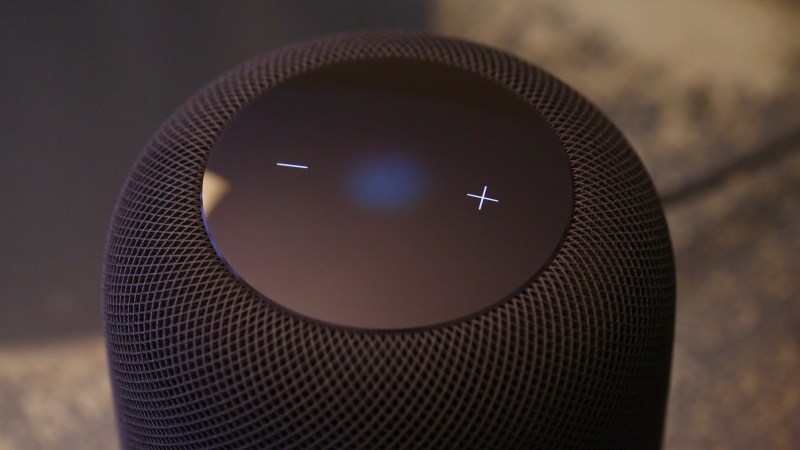
Above: Volume up and down buttons appear and disappear on HomePod’s top; you can tap between them to play, pause, and skip tracks.
There’s also a small, semi-weird design decision that some people will like more than others: HomePod doesn’t illuminate or provide any other sense that it’s turned on after it’s just been plugged in. Other devices tend to offer a small chime or light to let you know they’re connected, either always or optionally. A quick green flash of the Siri light on top wouldn’t hurt.
Pro: It offers low-distortion audio at loud volumes
As Apple’s late CEO Steve Jobs used to say about design, “It’s not just what it looks like and feels like. Design is how it works.” Since it’s supposed to be a speaker first and foremost, how HomePod works (and doesn’t work) is more important to me than how it looks. Over the years, I’ve come to expect excellent audio performance from any speaker at or above the $300 price point, and though the $349 iPod Hi-Fi fell short of that mark, it was a rare exception.
The two most positive things I can say about HomePod’s audio performance are that it can be turned up louder than one would ever expect from its size, and that it does a very good job of controlling the performance of its speaker drivers at all volume levels. When Apple’s Phil Schiller introduced the HomePod, he said that it would “rock the house,” and that description is fairly accurate.
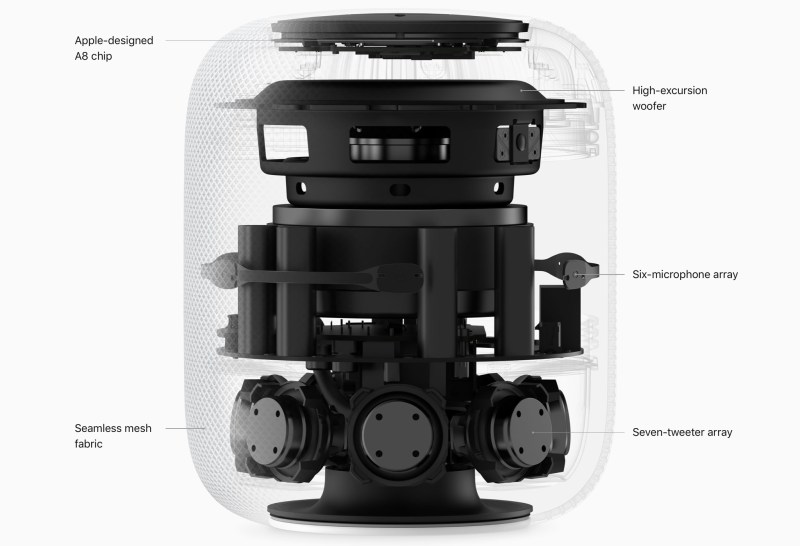
HomePod pairs one upward-firing woofer (bass driver) with seven tweeters that project higher-pitched sounds in a circle. The concept is that in the unlikely event that you have a power outlet in the middle of a room and place HomePod there, you can listen to music from pretty much any angle. Alternately, if you place HomePod in any other part of a room, such as in a corner or against a wall, it can use its microphones and Apple A8 processor to adjust its sound so it’s good wherever it’s placed.
In my testing, HomePod sounded pretty much the same no matter where I put it. Whether that’s “good” or not depends on your frame of reference, but I can say that I was generally impressed by the quality of the bass — atypically detailed and capable of some real lows for a small speaker — and the precision of the treble, as well as the speaker’s non-existent noise floor. HomePod is capable of utter silence, as well as crisp high- and low-frequency performance at normal volumes, and very controlled performance even when it’s at its absolute volume peak. It very nearly matches the old iPod Hi-Fi in top volume, which is astonishing given their different sizes.
Con: We didn’t love the overly bassy, mid-recessed sound
If HomePod was a $99 speaker or even a $199 speaker, its sonic skew — solid highs and lows, but weak mids — would be easy to accept. But having tested many great $299 all-in-one speakers over the years, I’ve become accustomed to expecting no compromise at that price: Highs are supposed to be handled by tweeters, mids (250-2000Hz, including voices and most musical instruments’ fundamentals) by midrange drivers, and lows by woofers. HomePod instead expects its tweeters and woofer to handle everything from highs to mids to lows. The result, which you can hear for yourself on recent pop songs like Taylor Swift’s “Shake It Off,” is very dominant bass with chirps of voice, but too little detail in the rest of the instrumentation.
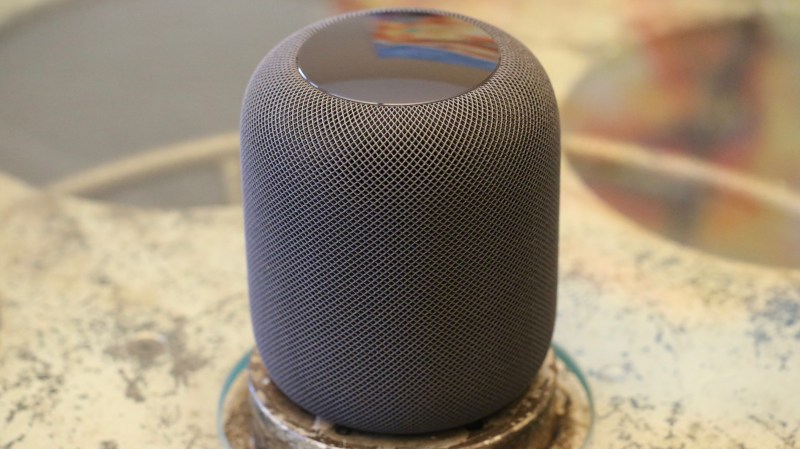
Audiophiles once derisively described woofer-and-tweeter-only speakers like HomePod as having “boom and tizz,” appealing to people who appreciate only the highs and lows of music, not what’s in between. But Beats headphones demonstrated that companies can get away with charging premium prices for that sort of sound if the enclosures are stylish enough and marketed aggressively.
Apart from lacking midrange drivers, HomePod’s bass driver sounds like it’s always turned up to 10 or 11. In test after test with HomePod and familiar songs in my library, the low thumps of bass became the dominant force in songs, drowning out any mids and leaving the highest-pitched notes as the only ones really standing out. Apple deserves credit for including such a powerful, controlled bass driver in HomePod’s small enclosure, but that’s really the only noteworthy accomplishment here. Ideally, there would be a way to throttle the bass back a bit, particularly at lower volumes.
Con: The lack of stereo sound is disappointing
If you take one look at HomePod next to the iPod Hi-Fi, you can probably guess why the smaller HomePod doesn’t offer stereo sound: As is its frequent issue, Apple prioritized form over function. Since both of these speakers launched at the same $349 price tag, this image gives you a very rough sense of how much stereo speaker hardware could be bought for the same amount of money as the HomePod, putting the wireless and A8 chips aside.
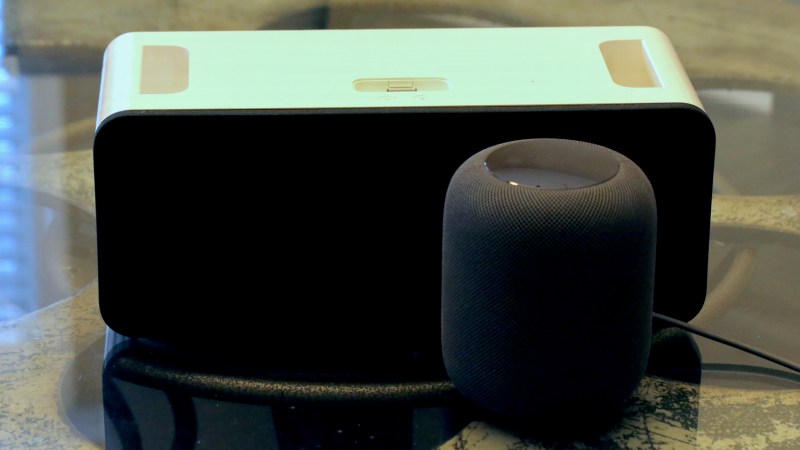
Does stereo sound matter? Yes. Almost every professionally recorded audio track produced over the past 60+ years was mastered in stereo. Apple even sells music as “Mastered for iTunes,” which goes beyond mastering in true stereo, paying extra attention to the high-quality sound modern audio sources are capable of. “We’re committed to delivering music as the artists and sound engineers intend it to be heard,” Apple says, and it’s true with iTunes. But that’s not what HomePod does.

Any track you’ve purchased on iTunes (or CD) has been designed to sound “the way the artist intended” when heard through excellent stereo speakers or headphones. On rare occasions, artists go even further than traditional stereo, having music mastered with proprietary 3D positional technologies such as QSound, which was memorably used in the mix of Madonna’s 1990 greatest hits album, The Immaculate Collection. In every case, the artist and sound engineers intended the music to be heard through separate left- and right-channel speakers, not through a single tube directly in front of your face.
That’s why the “breakthrough” HomePod’s approach to stereo sound is almost mystifying: It’s just not there. Yes, Apple was limited by the Echo-esque shape it chose: With $349 worth of components, it could have built a wide iPod Hi-Fi-like box with left and right sides, including the same or similar audio drivers found in HomePod. But instead it followed Amazon’s Echo lead and went with a vertical tube that makes traditional stereo sound difficult to perform.
To provide a semblance of stereo audio, Apple says that HomePod’s audio processor analyzes music, determines what it’s hearing, and tries to place certain instruments on certain tweeters to approximate a soundstage. In practice, however, while you can hear individual instruments, HomePod doesn’t really make them sound like they’re floating on a virtual stage in front of you. In distinctively stereo tracks I tested, including “Express Yourself” from the aforementioned Madonna album and the opening of Edwyn Collins’ “A Girl Like You,” stereo mixes were flattened, and I didn’t get the sense that the audio engineers’ left or right channel data was being faithfully replicated in HomePod.
When HomePod was introduced, there was a suggestion that two units would be able to function as stereo pairs. Over the past few weeks, Apple has made that somewhat ambiguous, hinting that it might use two synchronized speakers in the same room merely to fill the space rather than performing in true stereo. Apple also delayed multi-room HomePod functionality until some point later this year. We’ll have to see how that all shakes out.
Con: Siri is … well, Siri
An excellent AI assistant is now table stakes for even inexpensive “smart speakers” — that’s why Amazon’s Echo Dot sells so well despite its limited sound. Unfortunately, despite a $300 price gap between the Echo Dot and HomePod, there’s no question whatsoever that Amazon’s hardware would win an AI battle. Loup Ventures quantified that this weekend by showing that Siri only answered 52 percent of questions correctly, lagging behind Alexa (64 percent), Google Assistant (81 percent), and Cortana (57 percent). So it’s fair to say that Siri is a mediocre digital assistant, and although it has improved a little in the music department for HomePod, it’s still not close to its best competitors.
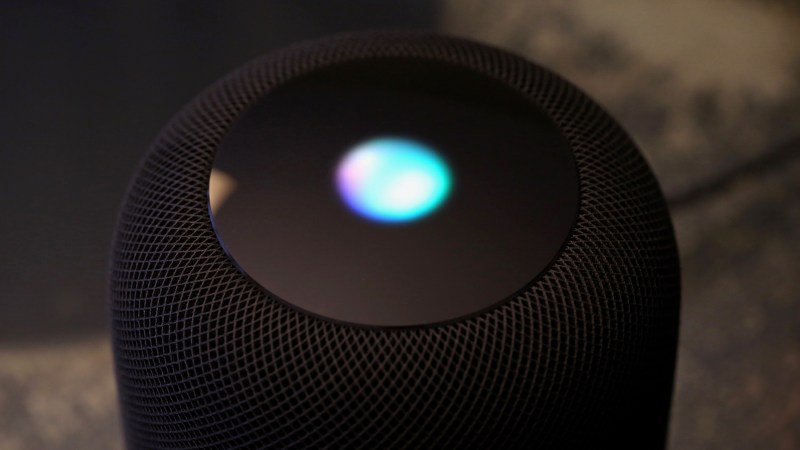
Above: Siri functionality is all that separates HomePod from being just another speaker
The nicest thing that can be said about the HomePod version of Siri is that it is very likely to hear and properly parse your requests. Six microphones inside are able to deliver what Apple calls “far-field Siri,” hearing your voice from a room away when you speak at a reasonable volume. I found that responsiveness and accuracy became spotty 10 feet away when music was playing, even if I shouted a command out, but under most conditions — including ones no rival product would even approximate — Siri could hear me.
Unfortunately, Siri on HomePod is plagued with the same issues it faces on other platforms: It misconstrues words, chases a decidedly wrong path rather than taking a moment to confirm intent, and has a very limited range of features. Unlike other Siri platforms, it can’t be used on HomePod to initiate phone or FaceTime Audio calls, and at some point, the exercise of calling out to the HomePod to do simple things like adjusting volume or skipping tracks one at a time becomes fatiguing. I began to feel that I’d made a mistake whenever I placed it far away, such as near a TV, because I wanted the immediacy of direct physical control.*
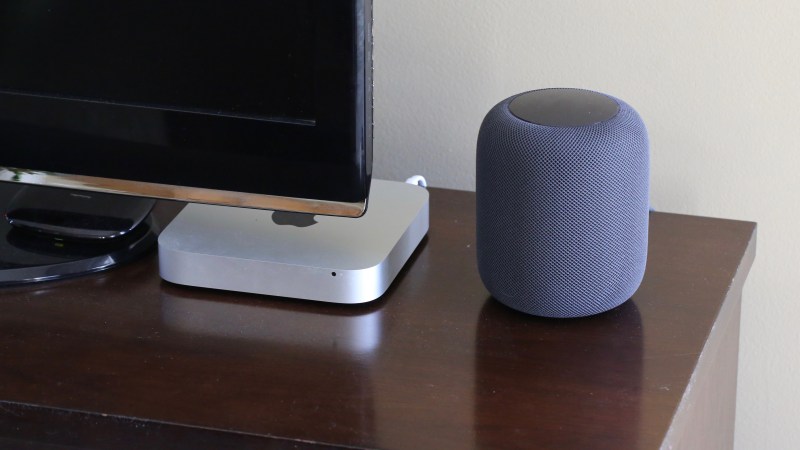
The lack of a screen or remote control input manifested in different ways. When I first set up HomePod, I deliberately chose an account without Apple Music to see what Siri would do. It began by playing explicit language songs from a source I couldn’t determine — was it streaming from my iPhone? — and it took me a little time to see that it had dug into my iTunes Match library and just started playing random songs.
As of now, Apple is touting HomePod as essentially a standalone speaker that has very limited interactions with iOS devices, Macs, and Apple TVs. I’m certain that greater support for other devices will eventually be coming, but for now, their absence is befuddling, and needing to rely on Siri for almost everything makes HomePod feel even worse than the typical “dumb speakers” everyone’s accustomed to using.
Conclusions
Having tested thousands of speakers and headphones over the years, and endured too many “this changes everything” pitches to recount, I can tell pretty quickly when a new piece of audio equipment is truly something special, or just overhyped by its manufacturer. On the other hand, I know that Apple has a way higher ratio of legitimately revolutionary products than its competitors, so I won’t write off such a pitch as easily when it’s coming from Cupertino.
Unfortunately, the HomePod strikes me as a miss, and a fairly big one at that. Despite the “breakthrough” language that accompanied both the HomePod and the iPod Hi-Fi before it, I don’t believe Apple’s speakers are going to revolutionize anything. HomePod is just another speaker, and barely a “smart” one at this point. I don’t find it fun to interact with, and don’t think that the sound is worthy of the $349 asking price; the same dollars can buy two Sonos One speakers with superior overall sound, true stereo, and support for multiple third-party services. The fact that HomePod will see non-trivial software updates won’t fix the hardware it’s missing, and even if Apple adds a true stereo mode, that won’t remedy the need for nearly $700 worth of hardware to achieve it.
I hope that Apple will stay in the smart speaker space and come up with better follow-ups to HomePod, because it’s clear that the company cares about quality audio. Improving Siri and offering a better balance of sonic performance for the price would go a long way towards winning me over to a house full of HomePod sequels.
Updated at 10:54 p.m. Pacific, Feb. 15: Apple has confirmed that HomePod’s rubber base can cause damage to oiled and waxed wood surfaces, in the form of circular white marks. The company suggests that users not place HomePod on such surfaces if they’re concerned about potential marking.
